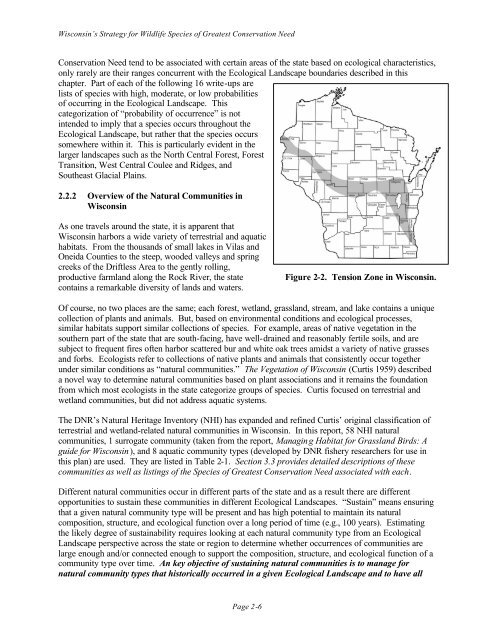Download - Wisconsin Department of Natural Resources
Download - Wisconsin Department of Natural Resources
Download - Wisconsin Department of Natural Resources
Create successful ePaper yourself
Turn your PDF publications into a flip-book with our unique Google optimized e-Paper software.
<strong>Wisconsin</strong>’s Strategy for Wildlife Species <strong>of</strong> Greatest Conservation Need<br />
Conservation Need tend to be associated with certain areas <strong>of</strong> the state based on ecological characteristics,<br />
only rarely are their ranges concurrent with the Ecological Landscape boundaries described in this<br />
chapter. Part <strong>of</strong> each <strong>of</strong> the following 16 write-ups are<br />
lists <strong>of</strong> species with high, moderate, or low probabilities<br />
<strong>of</strong> occurring in the Ecological Landscape. This<br />
categorization <strong>of</strong> “probability <strong>of</strong> occurrence” is not<br />
intended to imply that a species occurs throughout the<br />
Ecological Landscape, but rather that the species occurs<br />
somewhere within it. This is particularly evident in the<br />
larger landscapes such as the North Central Forest, Forest<br />
Transition, West Central Coulee and Ridges, and<br />
Southeast Glacial Plains.<br />
2.2.2 Overview <strong>of</strong> the <strong>Natural</strong> Communities in<br />
<strong>Wisconsin</strong><br />
As one travels around the state, it is apparent that<br />
<strong>Wisconsin</strong> harbors a wide variety <strong>of</strong> terrestrial and aquatic<br />
habitats. From the thousands <strong>of</strong> small lakes in Vilas and<br />
Oneida Counties to the steep, wooded valleys and spring<br />
creeks <strong>of</strong> the Driftless Area to the gently rolling,<br />
productive farmland along the Rock River, the state<br />
contains a remarkable diversity <strong>of</strong> lands and waters.<br />
Of course, no two places are the same; each forest, wetland, grassland, stream, and lake contains a unique<br />
collection <strong>of</strong> plants and animals. But, based on environmental conditions and ecological processes,<br />
similar habitats support similar collections <strong>of</strong> species. For example, areas <strong>of</strong> native vegetation in the<br />
southern part <strong>of</strong> the state that are south-facing, have well-drained and reasonably fertile soils, and are<br />
subject to frequent fires <strong>of</strong>ten harbor scattered bur and white oak trees amidst a variety <strong>of</strong> native grasses<br />
and forbs. Ecologists refer to collections <strong>of</strong> native plants and animals that consistently occur together<br />
under similar conditions as “natural communities.” The Vegetation <strong>of</strong> <strong>Wisconsin</strong> (Curtis 1959) described<br />
a novel way to determine natural communities based on plant associations and it remains the foundation<br />
from which most ecologists in the state categorize groups <strong>of</strong> species. Curtis focused on terrestrial and<br />
wetland communities, but did not address aquatic systems.<br />
The DNR’s <strong>Natural</strong> Heritage Inventory (NHI) has expanded and refined Curtis’ original classification <strong>of</strong><br />
terrestrial and wetland-related natural communities in <strong>Wisconsin</strong>. In this report, 58 NHI natural<br />
communities, 1 surrogate community (taken from the report, Managing Habitat for Grassland Birds: A<br />
guide for <strong>Wisconsin</strong> ), and 8 aquatic community types (developed by DNR fishery researchers for use in<br />
this plan) are used. They are listed in Table 2-1. Section 3.3 provides detailed descriptions <strong>of</strong> these<br />
communities as well as listings <strong>of</strong> the Species <strong>of</strong> Greatest Conservation Need associated with each.<br />
Different natural communities occur in different parts <strong>of</strong> the state and as a result there are different<br />
opportunities to sustain these communities in different Ecological Landscapes. “Sustain” means ensuring<br />
that a given natural community type will be present and has high potential to maintain its natural<br />
composition, structure, and ecological function over a long period <strong>of</strong> time (e.g., 100 years). Estimating<br />
the likely degree <strong>of</strong> sustainability requires looking at each natural community type from an Ecological<br />
Landscape perspective across the state or region to determine whether occurrences <strong>of</strong> communities are<br />
large enough and/or connected enough to support the composition, structure, and ecological function <strong>of</strong> a<br />
community type over time. An key objective <strong>of</strong> sustaining natural communities is to manage for<br />
natural community types that historically occurred in a given Ecological Landscape and to have all<br />
Page 2-6<br />
Figure 2-2. Tension Zone in <strong>Wisconsin</strong>.



![Nature program winter schedule [PDF] - Wisconsin DNR](https://img.yumpu.com/22471254/1/190x245/nature-program-winter-schedule-pdf-wisconsin-dnr.jpg?quality=85)
![City of Middleton [PDF] - Wisconsin Department of Natural Resources](https://img.yumpu.com/22300392/1/190x245/city-of-middleton-pdf-wisconsin-department-of-natural-resources.jpg?quality=85)

![Wetland Conservation Activities [PDF] - Wisconsin Department of ...](https://img.yumpu.com/21975633/1/190x245/wetland-conservation-activities-pdf-wisconsin-department-of-.jpg?quality=85)




![Baraboo River Region[PDF] - Wisconsin Department of Natural ...](https://img.yumpu.com/21975619/1/190x245/baraboo-river-regionpdf-wisconsin-department-of-natural-.jpg?quality=85)





